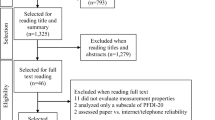Abstract
Introduction and hypothesis
The aim of this study was to investigate the reliability and validity of the Turkish version of the Pelvic Floor Distress Inventory-20 (PFDI-20).
Methods
One hundred and twenty-eight women with pelvic floor disorders, including pelvic organ prolapse, urinary incontinence, and anal incontinence were enrolled in the study. The Turkish version was developed using forward back translation. Construct validity was examined by correlation of clinical methods. Interclass correlation coefficients (ICC) compared the PFDI-20 and subscale scores. Cronbach’s alpha assessed the internal consistency of the Turkish version.
Results
The PFDI-20 has three subscales. The test–retest reliability of the PFDI-20 and subscale was excellent (ICC 0.96 to 0.98, p < 0.001). Cronbach’s alpha value (0.79) was moderate for the PFDI-20. Construct validity demonstrated that the PFDI-20 and each subscale displayed significant correlation with other clinical methods used (p < 0.05).
Conclusions
The PFDI-20 is a valid and reliable condition-specific questionnaire for Turkish women with pelvic floor disorders.
Similar content being viewed by others
References
Bump RC, Norton PA (1998) Epidemiology and natural history of pelvic floor dysfunction. Obstet Gynecol Clin North Am 25:723–746
Barber MD, Kuchibhatla MN, Pieper CF, Bump RC (2001) Psychometric evaluation of comprehensive condition-specific quality of life instruments for women with pelvic floor disorders. Am J Obstet Gynecol 185(6):1388–1395
Barber MD, Walters MD, Bump RC (2005) Short forms for two condition-specific quality of life questionnaires for women with pelvic floor disorders (PFDI-20 and PFIQ-7). Am J Obstet Gynecol 193:103–113
Teleman P, Stenzelius K, Iorizzo L, Jakobsson U (2011) Validation of the Swedish short forms of the Pelvic Floor Impact Questionnaire (PFIQ-7), Pelvic Floor Distress Inventory (PFDI-20) and Pelvic Organ Prolapse/Urinary Incontinence Sexual Questionnaire (PISQ-12). Acta Obstet Gynecol Scand 90(5):483–487
El-Azab A, Abd-Elsayed AA, Imam HMK (2009) Patient reported and anatomical outcomes after surgery for pelvic organ prolapse. Neurourol Urodyn 28:219–224
De Tayrac R, Mathé ML, Bader G, Deffieux X, Fazel A, Fernandez H (2007) Development of a linguistically validated French version of two short-form, condition-specific quality of life questionnaires for women with pelvic floor disorders (PFDI-20 and PFIQ-7) [in French]. J Gynecol Obstet Biol Reprod 36:738–748
Acquadro C, Jambon B, Ellis D, Marquis P (1996) Language and translations issues. In: Spilker B (ed) Quality of life and pharmacoeconomics in clinical trials. Lippincott-Raven, Philadelphia, pp 575–585
Swift S, Morris S, McKinnie V, Freeman R, Petri E, Scotti RJ et al (2006) Validation of a simplified technique for using the POPQ pelvic organ prolapse classification system. Int Urogynecol J 17:615–620
Swift SE, Tate SB, Nicholas J (2003) Correlation of symptoms with degree of pelvic organ support in a general population of women: what is pelvic organ prolapse? Am J Obstet Gynecol 189:372–377
Ellerkmann RM, Cundiff GW, Melick CF, Nihira MA, Leffler K, Bent AE (2001) Correlation of symptoms with location and severity of pelvic organ prolapse. Am J Obstet Gynecol 185:1332–1337
Lukacz ES, Lawrence JM, Burchette RJ, Luber KM, Nager CW, Buckwalter JG (2004) The use of Visual Analog Scale in urogynecologic research: a psychometric evaluation. Am J Obstet Gynecol 191(1):165–170
Cam C, Selcuk S, Asoglu MR, Tug N, Akdemir Y, Ay P, Karateke A (2011) Validation of the Wexner scale in women with fecal incontinence in a Turkish population. Int Urogynecol J 22:1375–1379
Bø K, Berghmans B, Mørkved S, Kampen MV (2007) Evidence-based physical therapy for the pelvic floor: bridging science and clinical practice. Churchill Livingstone Elsevier, Oxford, pp 63–68
Wall L, DeLancey JO (1991) The politics of prolapse: a revisionist approach to disorders of the pelvic floor in women. Perspect Biol Med 34:486–496
Cronbach LJ (1951) Coefficient alpha and the internal structures of tests. Psychometrika 3:297–334
Digesu GA, Chaliha C, Salvatore S, Hutchings A, Khullar V (2005) The relationship of vaginal prolapse severity to symptoms and quality of life. BJOG 112(7):971–976
Shumaker SA, Wyman JF, Uebersax JS, McClish D, Fantl JA (1994) Health-related quality of life measures for women with urinary incontinence: the incontinence impact questionnaire and the urogenital distress inventory. Qual Life Res 3:291–306
Uebersax JS, Wyman JF, Shumaker SA, McClish DK, Fantl JA (1995) Short forms to assess life quality and symptom distress for urinary incontinence in women: the incontinence impact questionnaire and the urogenital distress inventory. Neurourol Urodyn 14(2):131–139
Patrick DL, Martin ML, Bushnell DM, Yalcin I, Wagner TH, Buesching DP (1999) Quality of life of women with urinary incontinence: further development of the incontinence quality of life instrument (I-QOL). Urology 53:71–76
Nunnally JC, Bernstein IH (1994) Psychometric theory, 3rd edn. McGraw-Hill Inc, New York
Kelleher CJ, Cardozo LD, Khullar V, Salvatore S (1997) A new questionnaire to assess the quality of life of urinary incontinent women. Br J Obstet Gynaecol 104:1374–1379
Portney LG, Watkins MP (1993) Foundation of clinical research. Application to practice. Appleton & Lange, Norwalk
Kaplan RM, Saccuzzo DP (2008) Validity. In: Psychological testing: principles, applications, and issues, 6th edn. Wadsworth Cengage Learning, Belmont, pp 133–156
Acknowledgements
We thank Mesut Akyol from Gülhane Military Academy of Medicine for help with statistical analysis and Phylis Erdogan for her active support.
Conflicts of interest
None.
Author information
Authors and Affiliations
Corresponding author
Electronic supplementary material
Below is the link to the electronic supplementary material.
ESM 1
(DOCX 13.6 kb)
Rights and permissions
About this article
Cite this article
Toprak Celenay, S., Akbayrak, T., Kaya, S. et al. Validity and reliability of the Turkish version of the Pelvic Floor Distress Inventory-20. Int Urogynecol J 23, 1123–1127 (2012). https://doi.org/10.1007/s00192-012-1729-8
Received:
Accepted:
Published:
Issue Date:
DOI: https://doi.org/10.1007/s00192-012-1729-8



